31 January 2025
How to Choose the Best Mobile App Development Company for Your Business Read MoreWhat factors influence developers and businesses in their decision to choose either React Native or Swift for creating high-performance iOS applications?
Companies across the globe are seeking innovative means of creating cross-platform mobile applications to which cross-platform development frameworks are applied. These are computer programs that enable apps to operate smoothly on various operating systems. Out of the best options, React Native and Swift are two of the most widely used and efficient iOS development technologies. Both serve as effective tools for developing iOS applications; however, they possess distinct purposes along with their respective advantages and disadvantages.
This post takes a deep dive into comparing two of the most popular technologies for iOS app development- React Native vs Swift. We’ll explore what sets each technology apart, how they stack up in real-world applications, and which one might be the perfect match for your next big project.
By examining React Native and Swift—two powerful tools that developers often rely on—you’ll discover how to create native mobile apps more efficiently.
When it comes to the popularity of mobile app development, there’s no sign of it slowing down anytime soon.
That’s why it’s a good idea to familiarize yourself with the top cross-platform development frameworks.
Here’s what you should know:
Here’s what you can expect to learn:
The mobile application sector is experiencing ongoing expansion, propelled by the extensive availability of high-speed mobile internet technologies, a rising dependence of consumers on mobile transactions, and the enhanced accessibility of app development technologies.
As of 2025, there are more than 8.66 billion mobile subscriptions worldwide, with projections indicating that this figure will surpass 9.4 billion by 2030.
In the first quarter of 2025, the Android operating system continued to dominate the global market, securing a market share exceeding 71%, while Apple’s iOS represented roughly 27.65% of smartphones utilized around the world.
The majority of mobile applications are created using native technologies. On Apple’s App Store, 79% of applications are developed in Swift, whereas on Google Play, 77% are constructed with Kotlin, and 20% utilize Jetpack Compose.
Non-native development has experienced steady growth, with Flutter and React Native emerging as the most popular cross-platform frameworks in mobile application development. In 2024, 15% of newly launched applications and games were developed using either of these platforms, resulting in approximately 6 billion downloads (6% of total downloads) and $8 billion in net revenue (9% of the total net revenue generated across the app stores).
Looking for a robust framework to develop your mobile app? Swift shines when it comes to native iOS performance, while React Native brings the advantage of cross-platform flexibility using JavaScript. Each has its own set of strengths, so the right choice really hinges on what your project requires. Let’s dive into a comparison of their features, pros, and cons to help you discover the perfect fit!
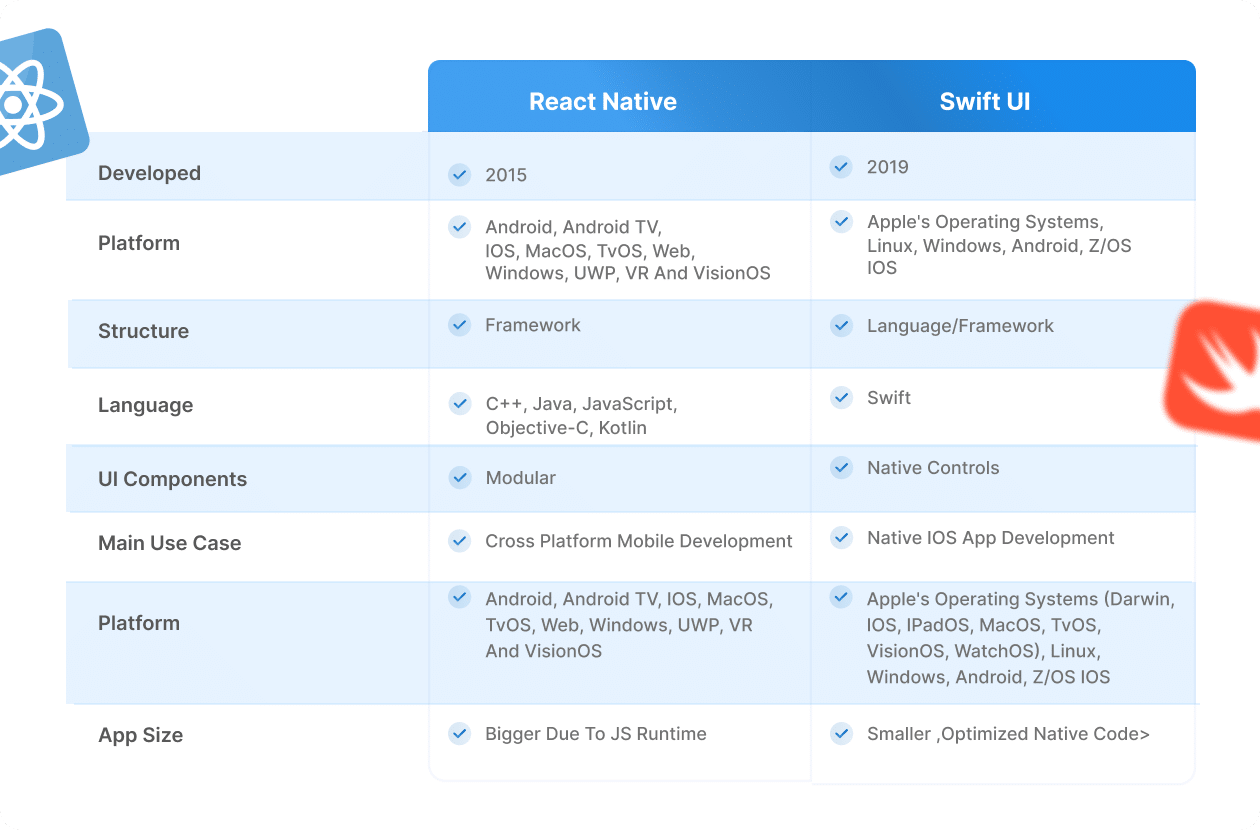
React Native is a widely-used mobile app framework built on JavaScript, enabling you to create apps that run smoothly on both iOS and Android. With this framework, you can develop applications for multiple platforms while using a single codebase.
Facebook introduced React Native as an open-source project back in 2015, and it quickly rose to prominence as one of the leading choices for mobile development within just a few years.
There are quite a few reasons why React Native has become a global sensation.
Since React Native focuses on building interfaces, it’s very much centered around views.
Let us go beyond and list out the top apps developed with React and know how they have transformed the specific industry.
The mobile app development market has a huge tendency to grow, the top giant companies are utilizing components of React Native for mobile application development. So therefore it has become one of the most efficient solutions within a few years of its launch. Let us move further and dig out more beneficial features of React native.


Thinking of building an android app with React Native then check out our exclusive guide for essential tips and insights-
Moving further, getting started with Swift is a breeze, thanks to its clear and expressive syntax along with modern features that you’ll definitely appreciate.
Swift is a versatile, high-level programming language that was created by Chris Lattner in 2010 for Apple Inc. and is now supported by a vibrant open-source community. It compiles down to machine code using an LLVM-based compiler. The first version of Swift hit the scene in June 2014, and since then, the Swift toolchain has been included in Xcode, starting with version 6, which was released in September 2014.
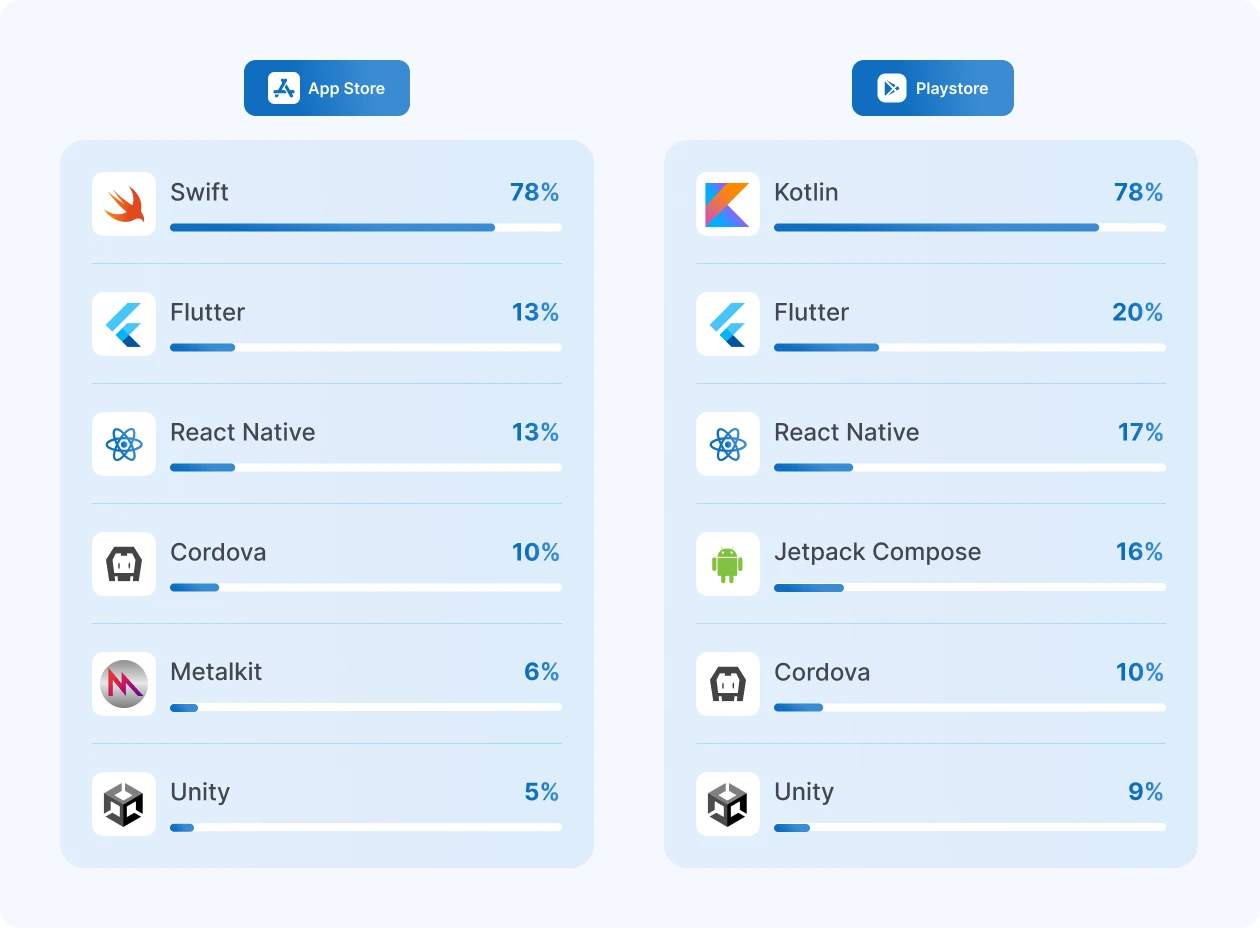
Swift is designed with safety in mind, ensuring that the software you create runs incredibly fast.
Swift and Swift UI are often thought of as the same thing, but they’re actually distinct, albeit closely related technologies. The difference between Swift UI and React Native is even more pronounced, as Swift UI functions as a UI framework, similar to how React Native operates. Swift is the programming language, while Swift UI is the tool for crafting UI code.
Swift 6.1 made its debut in March 2025, bringing along a host of new language enhancements aimed at boosting productivity, improving diagnostics, introducing package traits, and continuing efforts to enhance data-race safety usability and compile times.
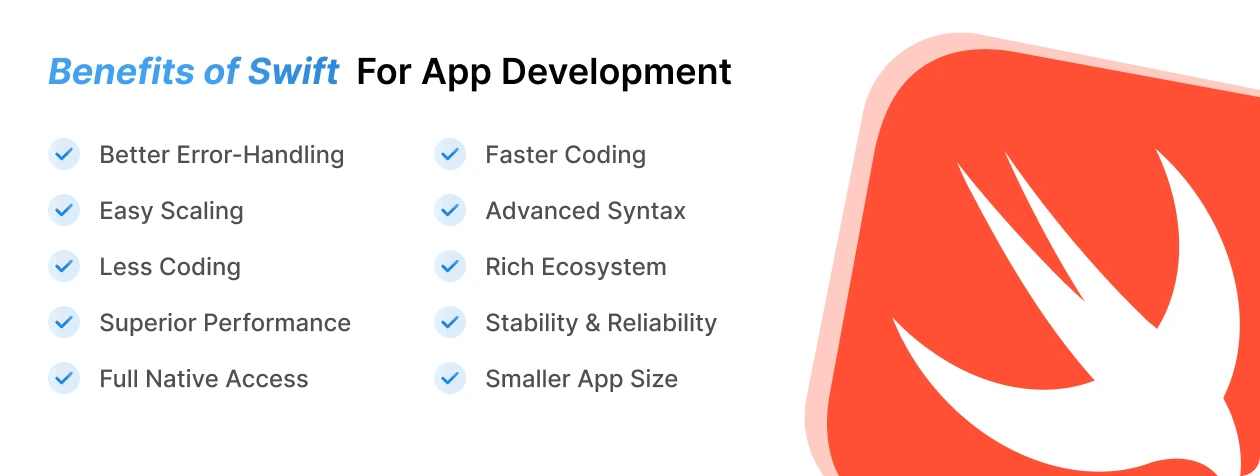
This is exclusively for Apple devices. Since Swift is designed for native platforms, you can only use it for apps on native devices. So, if you want to create apps for both Android and iOS, you’ll need to develop a separate app for each platform.

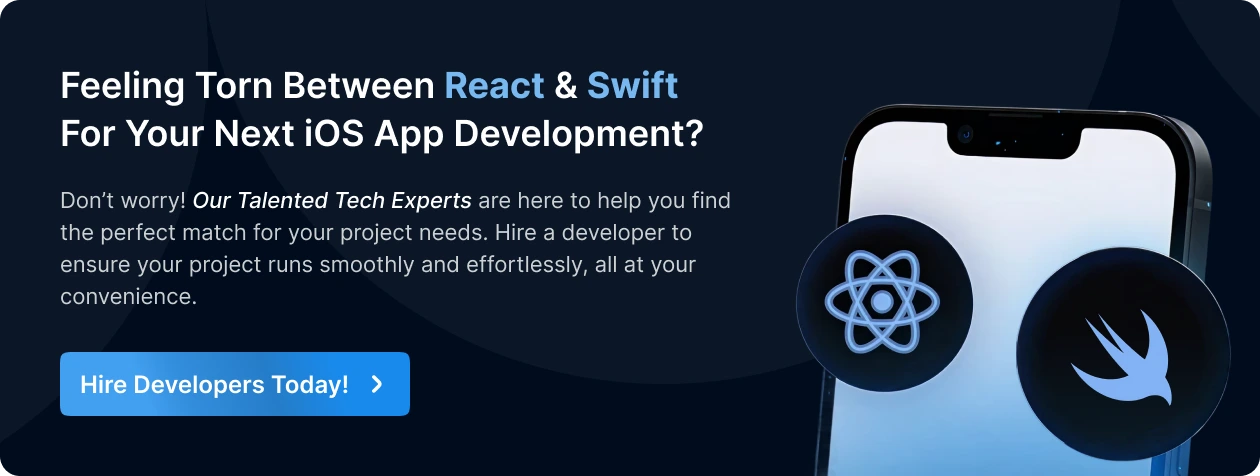
Swift or react native are two major contenders in the mobile development arena, each boasting its own set of strengths and weaknesses. Let’s take a closer look at how they stack up against each other to help you make a well-informed choice.
| Metrics | React Native | Swift |
|---|---|---|
| Market Share (Est.) | 0.67% | 0.06% |
| Ranking | #19 | #6 |
| Companies started using React Native (2025) | 25116 | 10041 |
React Native has really taken off, especially because it allows developers to create apps for both iOS and Android without starting from scratch.
On the other hand, Swift is Apple’s go-to language for iOS development, which makes it a key player in Apple’s world.
Since market shares can change, it’s always a good idea to check the latest stats for the most accurate comparison.
As we know, React Native is built on JavaScript, so when we’re looking at React Native vs Swift, we’re also indirectly comparing Swift to JavaScript. Given that React Native is a JavaScript framework, it tends to be more popular in the market compared to Swift.
When it comes to the Libraries and Widgets category, React Native faces tough competition from JQuery UI, which holds a market share of 28.20%, followed by Popper.JS at 10.41%, and AOS with 9.72%.
Swift
On the other hand, Swift is a versatile, compiled programming language developed by Apple Inc. for building applications on iOS, OS X, watchOS, and tvOS.
In the Languages category, Swift’s top competitors include JavaScript, dominating with a whopping 96.24% market share, followed by Java at 2.35%, and C with 0.82%.
Looking at the geographical distribution of Swift users, the United States leads with 3,894 customers (54.12%), followed by India with 829 (11.52%), and the United Kingdom with 613 (8.52%).
Conclusion:
React Native is a standout in the market, leading the pack in both market share and developer enthusiasm. Its ability to work across platforms, combined with a solid JavaScript base, makes it an ideal choice for businesses aiming for a wide reach and efficiency.
On the other hand, if you’re focused solely on Apple and need top-notch performance, Swift is still the way to go.
Swift vs React Native Performance
| Performance Characteristic | React Native | Swift |
|---|---|---|
| CPU Consumption | In-efficient | Highly efficient |
| Memory Usage | Highly efficient | In-efficient |
| GPU Speed | Moderately efficient | In-efficient |
When it comes to comparing the performance of React Native and Swift, there are quite a few factors to consider, like GPU speed, CPU usage, and memory management, among others.
In tests, React Native tends to outperform Swift in memory usage and GPU speed, while Swift takes the lead in CPU consumption. Plus, developers have the advantage of easily integrating native code into their React Native apps and utilizing various tools for different tasks. So, when it comes to performance, React Native has the edge over Swift.
In terms of memory management and GPU speed, React Native shines brighter than Swift, but Swift definitely has the upper hand in CPU consumption. Overall, React Native comes out on top in the performance race against Swift.
React Native and Swift Platform Support
| Category | React Native | Swift |
|---|---|---|
| Supported OS | iOS, Android, Web, Windows, macOS, tvOS, visionOS | iOS, macOS, watchOS, tvOS, visionOS |
| Focus | Cross-platform | Apple ecosystem |
React Native
React Native is a game-changer for cross-platform development, letting you use a single codebase to create apps for both iOS and Android with ease. Its community and partners have expanded its capabilities to include macOS, Windows, visionOS, tvOS, and even the web. This makes it a fantastic option for businesses looking to reach multiple platforms while enjoying shared components and quicker updates.
Swift Platform
Swift is tailored for Apple’s ecosystem, providing seamless integration with iOS, macOS, watchOS, tvOS, and visionOS. Although it has some limited support for Linux and Windows, Swift truly shines when it comes to crafting high-performance, native apps for Apple devices, ensuring users have the best experience and smooth access to hardware.
Conclusion:
For startups and businesses aiming for extensive platform coverage and cost-effectiveness, React Native is the way to go. However, if you’re focused on creating high-performance apps exclusively for Apple, Swift is in a league of its own. Choose between React Native or Swift based on your target audience and platform needs.
React Native vs Swift User Experience (UX) and UI
React Native
React Native allows developers to create user interfaces that feel native by using JavaScript libraries. This means you can build UI components that work seamlessly on both iOS and Android from a single codebase. It connects with native components through a bridge, which helps achieve that almost-native look and feel.
However, this method can sometimes lead to minor inconsistencies and might need regular tweaks to stay in sync with platform updates. While React Native generally provides a smooth experience for most business applications, it might not always reach the same level of polish and fluidity as fully native iOS apps, particularly in more complex or graphics-intensive situations.
Swift
Swift, particularly with SwiftUI, gives developers direct access to Apple’s native APIs and UI frameworks. This allows for the creation of pixel-perfect, highly responsive, and visually stunning user experiences specifically designed for iOS devices.
Swift apps are deeply integrated with iOS, ensuring consistent performance, advanced animations, and a stable interface that aligns perfectly with Apple’s design standards. This native approach offers more customization options, smoother transitions, and better management of intricate visual effects, making Swift the go-to choice for apps where top-notch UX and UI are crucial.
Conclusion:
When it comes to projects that demand the very best in iOS user experience and UI, Swift stands out as the top choice. On the other hand, if you’re looking for a quick, cost-effective way to develop across platforms while maintaining decent UI consistency, React Native is a strong contender. Ultimately, the choice between Swift or react native should hinge on your app’s design complexity, performance requirements, and overall platform strategy.
React native and swift Maintenance and Stability
| Category | React Native | Swift |
|---|---|---|
| Maintenance | Frequent updates & dependency management needed | Moderate – may face compatibility issues |
| Stability | Easier maintenance with native tools | High – stable and reliable under Apple ecosystem |
React Native
React Native apps need constant care when it comes to library updates, managing dependencies, and conducting regular tests to keep everything running smoothly. After version updates or when using outdated third-party libraries, compatibility issues can pop up, making maintenance a bit trickier. Writing clean, modular code and using automated testing frameworks can really help simplify the maintenance process. However, the fast-paced nature of updates and the JavaScript bridge can sometimes lead to unexpected bugs or performance issues. It’s crucial to prioritize user feedback and stick to a structured update schedule to ensure ongoing reliability and build user trust.
Swift
Swift apps enjoy the benefits of Apple’s strong ecosystem, which translates to high stability and easier maintenance. Thanks to its statically-typed nature, expressive syntax, and solid API stability, Swift reduces runtime errors and makes debugging a breeze. With fewer dependencies on third-party libraries, there are also fewer compatibility headaches after OS updates.
Swift’s seamless integration with Xcode and native tools allows for streamlined code management and efficient error tracking, making it simpler to maintain complex apps and ensuring they remain reliable over the long haul.
Conclusion:
While Swift provides better stability and easier maintenance for iOS apps, React Native demands a bit more attention but allows for quicker cross-platform updates. Your choice should depend on the complexity of your app and the specific needs of the platform.

Swift vs React Native Developer Availability and Community Support
| Category | React Native | Swift |
|---|---|---|
| Developer Availability | Large JS talent pool; easy & cost-effective to hire | Smaller, Apple-focused talent pool |
| Community Support | Large, active open-source community | Strong Apple-backed community; 64K+ GitHub stars |
React Native Developer
React Native, which is built on JavaScript, has the advantage of tapping into a huge global talent pool—over 65% of developers prefer JavaScript, making it a breeze to find React Native experts without breaking the bank. Its open-source nature and widespread use foster a lively community and a wealth of third-party resources, boasting over 113k stars on GitHub and solid backing from major players like Meta and Microsoft. There’s no shortage of documentation and learning materials, plus hiring options are flexible across job boards, agencies, and freelance platforms. This all positions React Native as a clear frontrunner in terms of developer availability and community support.
Swift Developer
Swift is on the rise and enjoys strong support from Apple, but its talent pool is smaller, focusing mainly on Apple platforms. The community is active, with meetups, Slack groups, and over 64k stars on GitHub, but finding seasoned Swift developers can be trickier and pricier, especially for larger or urgent projects.
That said, the Swift community provides excellent official documentation and solid peer support, particularly for iOS development. While Swift’s community is strong, it doesn’t quite match the size or versatility of React Native’s.
In conclusion, React Native clearly outshines Swift when it comes to developer availability and community support, making it a more straightforward and cost-effective choice for building and scaling projects across different platforms.
Swift vs React Native Access to Native Features
| Category | React Native | Swift |
|---|---|---|
| Access to Native Features | Uses bridge modules for native APIs; may lag on newest iOS features or require custom native modules | Full, direct access to all iOS APIs and hardware; instant support for latest Apple features |
React Native
React Native opens the door to a variety of native device features—like the camera, geolocation, and notifications—through bridge modules that link JavaScript code with native APIs. This method works quite well for most standard functionalities, but when it comes to the latest or more specialized native APIs, it can sometimes fall short compared to Swift. Developers may find themselves needing to create custom native modules in Swift or Kotlin vs Java to achieve full functionality. While React Native meets the needs of most business applications, it might not keep pace with the cutting-edge iOS features that Apple rolls out each year.
Swift Access to Native Features
On the other hand, Swift provides direct and unrestricted access to all native iOS APIs and hardware capabilities, including the latest features that Apple unveils annually. Since Swift compiles to native code and integrates seamlessly with Apple’s frameworks, developers can tap into advanced device functionalities—like FaceID, ARKit, and the newest system-level APIs—without having to wait for third-party support or find workarounds. This makes Swift the go-to choice for apps that demand thorough, up-to-date native feature integration and top-notch performance.
Conclusion:
When it comes to having immediate and complete access to native iOS features, Swift takes the lead. React Native is adequate for most standard requirements, but it may struggle to keep up with the latest or more advanced device capabilities.
React Native vs Swift Cost Efficiency
| Category | React Native | Swift |
|---|---|---|
| Cost Efficiency | Cross-platform code reduces time and cost; developers are more affordable and easier to hire. | iOS-only projects cost-effective; multi-platform requires separate codebase and higher developer rates |
React Native
React Native stands out for cost efficiency, primarily due to its cross-platform capabilities. By enabling a single codebase for both iOS and Android, React Native reduces development time and resource requirements, leading to lower overall expenses.
This approach is particularly advantageous for startups or businesses aiming to reach multiple platforms without doubling their investment. React Native developers are generally more affordable and easier to find, further driving down costs. Hourly rates for React Native developers are consistently lower or comparable across regions, especially when considering the savings from not maintaining separate teams.
Swift Cost Efficiency
Swift, in contrast, is optimized for iOS development. While hiring Swift developers for iOS-only projects can be cost-effective, expanding to Android requires building and maintaining a separate codebase and team, significantly increasing costs.
Additionally, the smaller pool of Swift developers can drive up rates, particularly for experienced talent. However, Swift’s superior performance and direct integration with Apple’s ecosystem can reduce long-term maintenance costs for complex or high-performance apps.
Conclusion:
React Native is generally more cost-efficient for projects targeting both iOS and Android, thanks to code reusability and a broader talent pool. Swift is cost-effective for iOS-only apps but becomes more expensive for multi-platform development. Choose React Native or Swift based on your platform targets and budget priorities.
Swift vs React Native Development Speed and Time to Market
| Category | React Native | Swift |
|---|---|---|
| Development Speed | Cross-platform code reuse (up to 90%) accelerates development | Native iOS development is fast for iOS-only projects |
| Time to Market | Hot reloading and shared codebase enable launches up to 33% faster | Multi-platform apps need separate codebases, slowing overall launch |
React Native
React Native really speeds up development and cuts down the time it takes to launch apps, especially when you’re looking to reach both iOS and Android users. Thanks to its cross-platform capabilities, developers can reuse as much as 90% of the code, which means no need for separate teams or running parallel development cycles for each platform.
Features like hot reloading allow developers to see changes instantly without having to recompile, making the debugging and UI tweaking process much smoother. Case studies indicate that React Native projects can be wrapped up up to 33% faster than similar Swift projects when targeting both platforms, making it a fantastic option for startups and businesses eager to launch quickly.
Swift
On the other hand, Swift is great for native iOS development but requires a different codebase and team for Android, which essentially doubles the workload and time if you want cross-platform support. Swift does have the advantage of Apple’s integrated development environment (Xcode) and its clean syntax, which can speed up iOS-specific projects. However, when it comes to multi-platform apps, Swift’s development process tends to be slower because of the need for simultaneous native development.
Conclusion:
When it comes to launching apps on both iOS and Android, React Native is the clear winner for quick development and faster time to market. Swift shines for iOS-only apps where top-notch native performance is essential.
React Native and Swift Learning Curve
| Category | React Native | Swift |
|---|---|---|
| Learning Curve | Smooth for developers familiar with JavaScript; plenty of resources and community support | Beginner-friendly for basic tasks; steeper for mastering advanced iOS frameworks and concepts |
React Native
React Native is known for its relatively smooth learning curve, especially for those developers who already have a grasp of JavaScript and web technologies. With its wealth of documentation, libraries, and a vibrant community, it’s quite welcoming for newcomers. That said, developers making the leap from web to mobile might encounter some hurdles due to the differences in architecture and mobile-specific concepts. Nevertheless, the plethora of resources available and the widespread use of JavaScript can really help smooth out the transition, making React Native a more accessible option for many, particularly those with a web development background.
Swift Learning Curve
Swift boasts a modern and clear syntax, along with tools like Swift Playgrounds, which makes it friendly for beginners. Apple goes the extra mile by providing comprehensive documentation and learning materials, which further ease the learning journey. While getting started with Swift is relatively straightforward, truly mastering iOS development involves diving into Apple’s frameworks and platform-specific concepts, which can be a bit daunting for those who are new to it. In summary, Swift offers a gentle learning curve for basic tasks, but it does get steeper as developers tackle more advanced iOS app development.
Conclusion:
React Native tends to be easier for developers who are already familiar with JavaScript, while Swift is beginner-friendly but demands more effort for those looking to excel in advanced iOS development. Ultimately, your choice should reflect your team’s background and the specific needs of your project. And if you want to streamline the process the definitely you must read our exclusive article on Top iOS app development tools used by top-grossing app companies
React Native vs Swift Platform Maturity
| Metrics | React Native | Swift |
|---|---|---|
| Maturity | Quite Young | Quite Young |
| Stability | Less Stable | More Stable |
React Native Platform
Since its debut in 2015, React Native has undergone a remarkable transformation and is now recognized as a mature, production-ready framework. By 2025, its New Architecture offers enhanced performance, while powerful tools like Expo make development smoother than ever.
Big names in tech, including Meta, Microsoft, and Shopify, not only utilize React Native but also actively contribute to its growth, which bolsters its stability and future prospects. The ecosystem surrounding React Native is extensive, with regular stable releases and a vibrant community that fosters continuous innovation and support.
Today, React Native powers cross-platform applications for billions of users, showcasing its reliability and application scalability.
Swift Platform
Launched by Apple in 2014, Swift has established itself as the gold standard for developing applications across iOS, macOS, watchOS, and tvOS. With each new release, Swift has introduced features that boost safety, performance, and developer productivity, such as refined syntax, better memory management, and a stable ABI.
As we look to Swift 6 and beyond, its capabilities continue to grow, making it even more adaptable and efficient. Its seamless integration with Apple’s ecosystem, along with strong support from both Apple and the open-source community, ensures that Swift remains the most stable and mature option for native development on Apple platforms.
Conclusion
In 2025, both React Native and Swift stand out as highly mature mobile app development frameworks. React Native shines for cross-platform projects with its expansive ecosystem, while Swift is unparalleled in terms of stability and depth within the Apple ecosystem. Your choice should align with your project’s platform strategy.
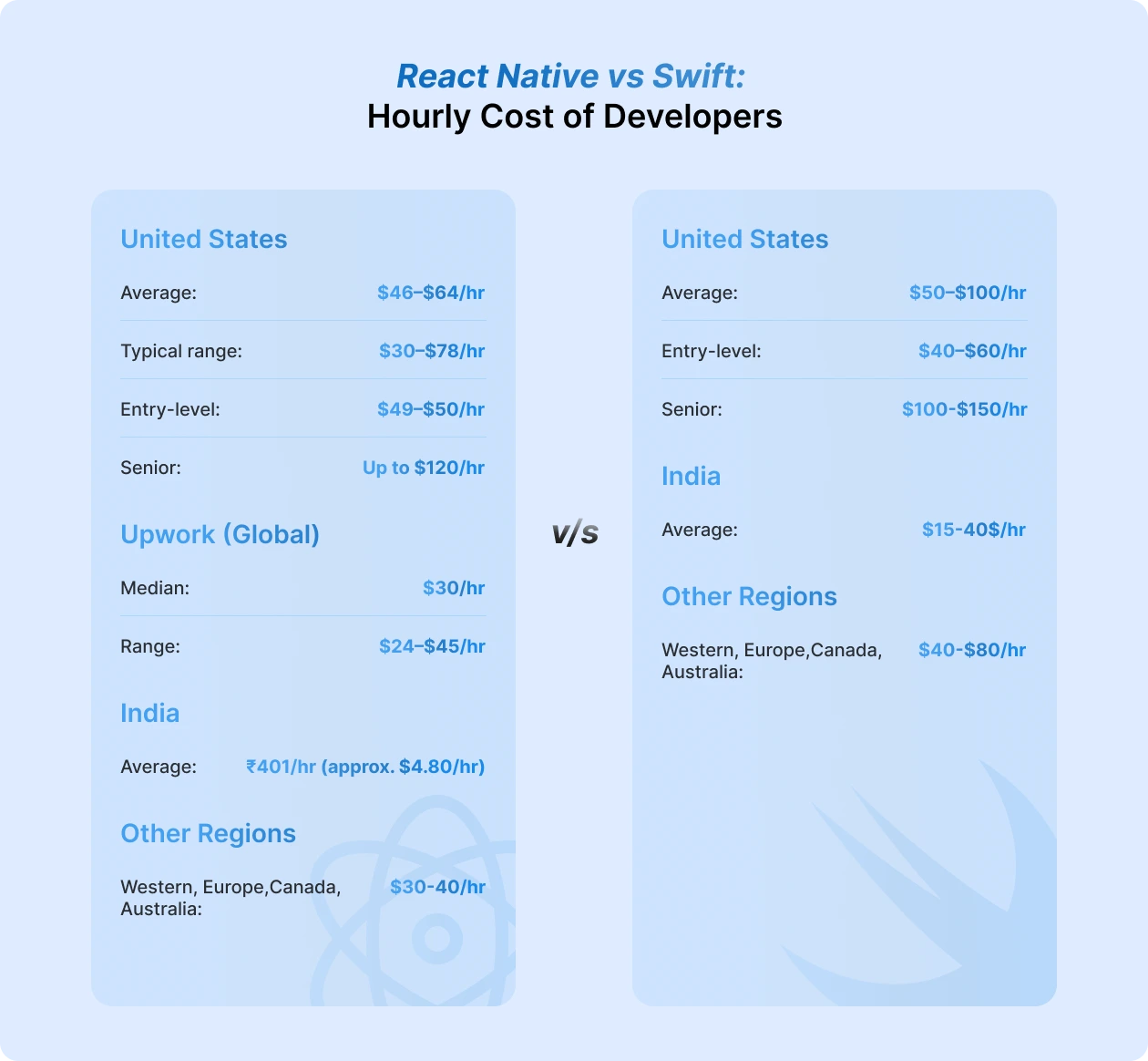
As the picture is clear the rates may vary by experience, location, technology and project complexity. Senior developers specialized with high skills charge high fees. The choice is based entirely on your project’s requirements and long-term objectives. When it comes to developer rates, Swift developers usually charge more than those working with React Native, particularly for senior roles or specialized iOS development.
To get more detailed cost analysis get in touch with the trusted mobile app development company and get their guidance before you start with your new venture.
Conclusion
React Native developers are often a more budget-friendly option, especially for projects that need to work across multiple platforms, as their average rates tend to be lower than those of Swift developers in most areas.
On the other hand, Swift developers, especially for complex iOS projects, can command higher hourly rates due to their expertise and the demand for their skills. If you’re looking for a cost-effective solution for multi-platform projects, React Native is the way to go; however, if you want top-notch, Apple-exclusive development, Swift is your best bet.
React Native and Swift Developer’s Availability
| Category | React Native | Swift |
|---|---|---|
| Developer Availability | Large global talent pool due to JavaScript’s popularity (65%+ of developers); easy and cost-effective to hire | Smaller, Apple-focused talent pool; harder and more expensive to hire experienced developers |
React Native
When it comes to choosing between React Native or Swift, React Native takes the lead in terms of developer availability. This is largely due to the widespread popularity of JavaScript, which is the backbone of React Native. With so many developers around the world skilled in JavaScript, it’s much easier and quicker to find the right talent and build your team.
React Native benefits from a vast pool of developers, as over 65% of them prefer JavaScript, the most popular programming language out there. This means you can easily find talented React Native developers for full-time positions, agencies, or freelance gigs without breaking the bank.
There are plenty of job boards, platforms, and communities that make hiring a breeze, and the high demand is perfectly matched by the supply, making it simple to scale your teams. Plus, this abundance of talent helps keep development costs competitive.
Swift Developer’s Availability:
On the other hand, when we look at Swift, the situation is a bit different. While Swift is gaining traction, it still has a smaller and more specialized talent pool. Since Swift is limited to Apple platforms, finding experienced developers or agencies can be trickier and often pricier, especially for larger or urgent projects.
Swift is still relatively new, and there are fewer developers who specialize in it compared to those working with JavaScript-based frameworks like React Native. This scarcity can slow down the hiring process and drive up costs, which can be a challenge for startups or businesses looking to scale quickly.
In conclusion,
Given how popular JavaScript is within the developer community, it’s pretty easy to find skilled JavaScript developers. On the other hand, Swift is relatively new, which means there are fewer opportunities to come across a team of experienced Swift developers or dedicated Swift development companies. According to the Stack Overflow 2022 survey, about 65.36% of developers consider JavaScript their go-to programming language. This statistic highlights React Native’s popularity in comparison to Swift.React Native clearly stands out when it comes to developer availability. It offers a larger, more accessible, and cost-effective talent pool compared to Swift, making it the ideal choice for rapid team scaling and cross-platform projects. Henceforth get in touch with Dev Story to hire React Native developers with the proficiency you need for your next project.
When examining the React Native vs Swift comparison, it is essential to comprehend their optimal use cases. Each framework demonstrates superiority in various situations depending on factors such as performance, scalability, development speed, and specific platform requirements.
React Native serves as an outstanding option for companies looking to develop quick, cost-efficient, and visually attractive applications that operate flawlessly on both iOS and Android platforms. It is especially advantageous for customer-oriented applications such as eCommerce, social networking, or on-demand service apps, where maintaining a consistent user experience across different platforms is crucial. The framework’s reusable components and cross-platform codebase greatly accelerate the development process while ensuring consistent performance and design.
React Native is also well-suited for MVPs (Minimum Viable Products) or projects that require a swift time-to-market without sacrificing stability. With strong community support, pre-built UI libraries, and access to third-party plugins, developers can effortlessly incorporate features, uphold scalability, and guarantee smooth updates — all while keeping expenses lower than those associated with native development.
You can leverage React Native iOS app platform in these scenarios:
Conversely, Swift is ideally suited for high-performance, intricate, and security-sensitive iOS applications. It is the preferred choice for premium applications such as banking, healthcare, and enterprise-level solutions that necessitate seamless integration with Apple’s ecosystem and stringent data protection standards.
Swift shines in applications featuring heavy graphics, advanced animations, or complex user interfaces, including AR/VR or gaming applications. Its long-term maintainability, stability, and native performance render it perfect for businesses intending to implement continuous updates and scalability over time.
It is mostly used in these scenarios:
Swift or react native? React Native is excellent for speed and cross-platform efficiency. Swift is the best option if you want native functionality and unwavering iOS performance. Choose according to the platform goals, budget, and complexity of your project.
Which One Should Your Business Choose?
Select Swift if:
Choose React Native if:

Which one should you choose: Swift or React Native?
It all depends on your business goals and needs. In fact, both Swift and React Native are strong tools with distinct advantages. Make sure the framework you choose fits your requirements by carefully weighing your target audience, project complexity, timing, and money. Making the correct decision will provide the groundwork for your app’s success in the cutthroat mobile industry. For expert guidance, consider consulting a cross-platform app development company to ensure the best fit for your project.
If React native offers a versatile, cost-effective solution to launch your app quickly on both iOS and Android, then Swift remains the recommended platform where efficiency, user experience, and native integration are the utmost.
For rapid growth and broad market reach React Native offers a sound balance of speed, accuracy and cross-platform coverage. And Swift focuses on delivering feature-rich apps for Apple devices with non comparable native capabilities and stability.
Hence React Native vs Swift differences in itself is a debate where both are the powerful tools with top-features and strength.
You just need to evaluate your target audience, your project’s requirements, timeline and budget carefully while selecting the best that align with your vision. Because the best choice will lead to the foundation of your app’s success in today’s competitive mobile market.
Henceforth, business growth with app development services offered by Dev Story can help choose the right technology stack for your startup’s success.
Get in touch and create exceptional user experience by utilizing the best framework for building your next dream app.